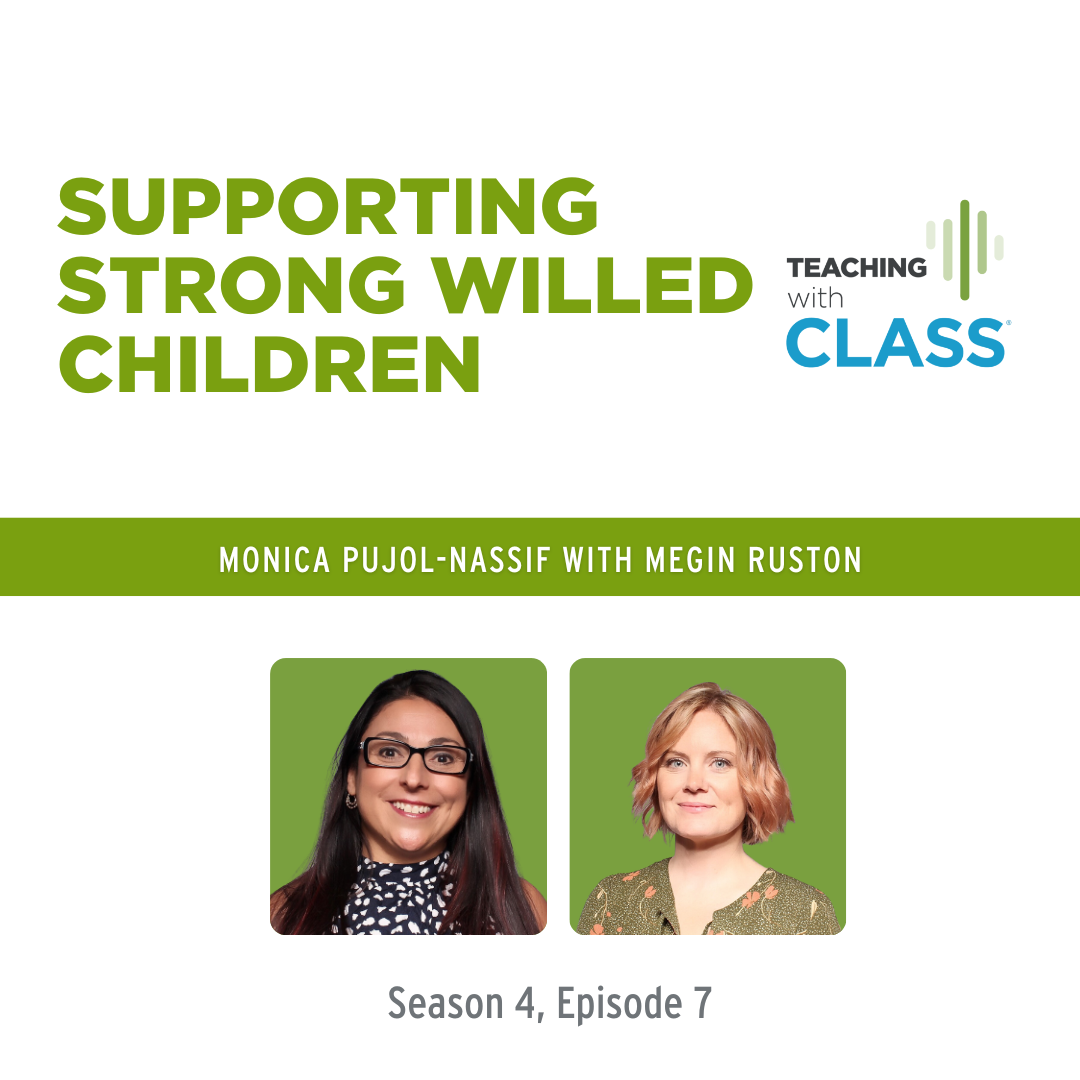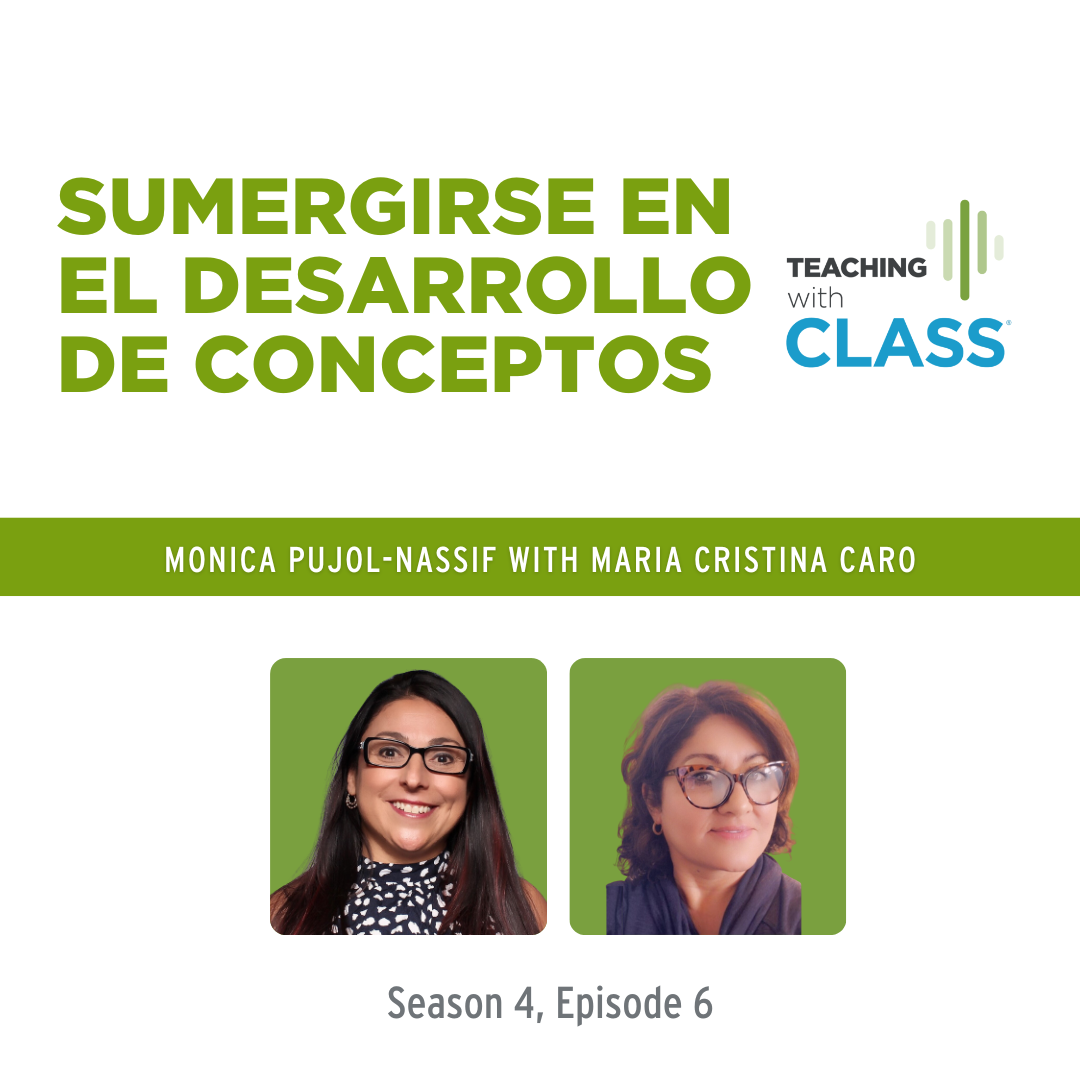Episode Transcript
Monica: Hello, and welcome to the Teaching with CLASS podcast, the podcast that gives you quick, actionable tips to easily implement in your classroom. I'm your host, Monica Pujol-Nassif.
In today's episode, we're talking about how to deal with very strong-willed children. In today’s episode, we are joined by Megin Ruston. She is our very own online course facilitation manager here at Teachstone. Megin, welcome. Super happy and grateful that you’re giving us your time and talking to us about this important topic requested by one of our winners of the class learning community and listener of the podcast.
Tell us a little bit about you before we start, please.
Megin: Hello, Monica. Thanks for inviting me. I'm also really excited to talk about this topic. I'm really happy that someone brought it up in the learning community.
Monica: We are just so happy when teachers—because this podcast is for our teachers—need something and we have a person like you who say, oh, I can do that. I can give you strategies to help you even when it's not easy. That's why we're super, super grateful that you are taking your time to do this with us.
Let's start with defining. What is a strong-willed child?
Megin: That's such a great question. What is a strong-willed child? What does that look like? When I hear people say they have a strong-willed child or they're working with a strong-willed child, it makes me wonder a couple of things.
First of all, what does that look like? When you say you have a strong-willed child, what are you seeing and hearing? That term has become a catch-all umbrella phrase that adults and caregivers use to describe some typical or even developmentally appropriate behaviors that you might see.
For example, if you're talking about toddlers, there are a lot of behaviors toddlers are well known for. One of them is defiance. You might think of a toddler as a strong-willed child because they are exhibiting defiant behaviors. Those are developmentally appropriate. Not to say they aren't challenging, but they are typical behaviors of a child that age.
The other thing we might be talking about though when we are describing strong-willed children is temperament. That is different than the natural developmentally appropriate behaviors you might see in a child.
Monica: Temperament. Let's talk a little bit about that because we can think of temperament and character. Can you explain a little bit?
Megin: Absolutely. Very broadly, temperament is in some ways similar to what we might call personality or character, but temperament is more stable over a person's lifetime. It is a natural, biological predisposition that people have at birth.
When we talk about personality or personality traits, those can change over a person's lifetime with growth or experiences. You might see a very extroverted person who experiences situations that might cause them to become more withdrawn, and vice versa. Those traits have changed because of a person's experiences. Temperament, though, tends to remain consistent over time.
Monica: When you talk about that, I immediately go to the classroom of infants because I can see an infant that has a harder time being comforted, or an infant that has a harder time adapting from home to the new classroom versus infants that are calm, easy going, and can adapt easily to different people even in the classroom. That's the beginning, and it grows over time. How does temperament change over time?
Megin: Temperament itself definitely tends to stay stable over time. In infancy, when we see babies who are maybe the ones who have a harder time calming down, later on, those might be the older preschoolers who, again, need a little bit more help from an adult reaching a regulated state once they've become upset. But definitely, the way we think about temperament and our perception of temperament in children has evolved over time a great deal.
For example, we used to categorize temperament in three very basic ways. It was easy, difficult, and slow to warm. The difficult children are the ones like you were saying. They have a harder time with disruption in their routine, they definitely thrive in a very consistent schedule, and they might have a harder time returning to a regulated state.
The easy, or what we used to call the easy children, are the ones who are very adaptable. They're the babies that can go with the flow or the children that don't get upset if there's a change in their routine, they're adaptable.
What we used to refer to as slow to warm are the children who will not necessarily engage in their environment right away. They're the ones who may stand off and observe for a bit, and they may need some support, or they may need some sort of coaxing to engage. Once they have established that comfort level, then they may start engaging with their environment or with new people. But they need some time to establish that security first.
We don't necessarily use those terms to describe temperament. Like I said, the way we talk about temperament has evolved quite a bit. When we're talking about temperament now, instead of difficult, you might hear the term feisty, or instead of slow to warm, you might hear some folks say cautious. This child is cautious, or this child is an observer. Instead of easy, we use terms like flexible or adaptable.
I hope your listeners are wondering what this has to do with strong-willed children. Those must be the difficult children. Not the case, though. I would say one trait, whether we're talking about toddlers who are displaying developmentally appropriate behaviors that are just part of their natural progression or we're talking about temperament, one characteristic that they share is flexibility versus rigidity, which is a temperament trait. Strong-willed children—if we're using that term—tend to be lower on flexibility or have a harder time with flexibility and are higher when it comes to rigidity.
Monica: You mentioned the teachers. I can just see them thinking of [...] in your classrooms. We are learning temperament is innate. We don't learn it. We are born with it. Yes, we can learn strategies, but it can't be necessarily a bad thing if we're born with it. Can you tell us about that? How do we understand these strong-willed children? What are the things that they are good at that we can use to teach them other skills?
Megin: Having a strong will is not necessarily a bad thing. I would argue that in adults, that is a trait we really admire, someone who can speak up for themselves or others, someone who exhibits incredible perseverance. The children who are exhibiting these behaviors, because this is an innate predisposition and it will follow them, maybe the adolescents who have a very strong sense of right and wrong. They may grow into adults who have a strong sense of justice. There are things that we like in adults that don't always look good on young children. They may not look good on the five-and-under crowd, but they are traits we really admire in adults.
Monica: You just made me think of when a child says, but why and tell me more? I'm not happy with that answer. You have to tell me more. What a great skill.
Megin: Right. There's a big difference between a child who is cooperative and one who is compliant. You may think that this child is exhibiting really frustrating behaviors like saying no, I don't want to do that or why do you want me to do this task? Why do I have to do it this way? Why can't I do it this way?
There's a big difference between cooperation and compliance. A child who can be cooperative may not necessarily agree with the way a situation has turned out but will cooperate for the greater good. If you think about cleanup time, the teacher may say, okay, it's almost time to go outside, we're going to clean up the paint. A strong-willed child may think, but I'm not done. I'm not finished with my project. I'm not done with my work. I don't want to clean up. Why do I have to clean up if I'm not done? But a cooperative child will still understand, okay, the sooner I clean up, the sooner we all get to go outside. I'm not happy that I have to stop my work, but I can be cooperative. Versus compliance that has more to do with sort of following a set of rules or conditions without question, without thinking. That compliance looks very different than cooperation. I would venture that compliance is not necessarily something we want to encourage. That can come with its own set of difficulties and safety concerns, someone who just follows. An adult has said this, I do not question it.
Monica: Thank you, Megin. You just made me think. As you were talking, you brought me back. When I transitioned from Florida to Arizona, I substituted for Head Start. I ended up staying for the rest of the year with this group because I couldn't leave them. Once they're mine, they're mine.
There was this child, and he loves making constructions. I learned this on day one. I didn't know I was going to stay, but on day one, he did it. On day two, he did it. On day three, now I intervened. He didn't want to clean up. It was a Head Start program in the morning. I did that one, and then there was another teacher in the afternoon, same classroom.
Obviously, we have to be considerate and leave the classroom neat so the other group will come and use it. He had such a hard time cleaning up his structures. I've never seen a child building the way that he built. I was able to implement concept development in creating planning and producing. He was amazing, but he had this problem. He did not want to clean up. It was so hard for him.
I remember coming up with, okay, we have three choices. We could clean up with the friends so we could move out and the friends in the afternoon will have a clean classroom. We could take pictures and then clean up, and we could show the pictures to Mom because that was his issue. He wants mom to see. The third one was, okay, we're going to leave it, and when Mom comes, she can look at the structure with you and then you guys can clean up together.
It wasn't easy to go through that process and for him to accept that he had a lot of good reasons why he didn't want to turn that down. It was a lot of work. It was a lot of time. It was a lot of inspiration. And he wanted Mom to see.
That could have been confused with it's time to clean up and you have to clean up rather than let's talk about this and why it's important. Yes, exactly how you said. He understood the importance of it. He's not very happy about it, but eventually, we didn't need to do the pictures anymore. Eventually, he just did it.
Megin: That's such a good point, Monica. When we're talking about very young children, we know that behavior is communication. With that behavior, that means these children are trying to tell us something that they cannot express verbally. Also, when we're talking about very young children, we're talking about humans who still don't have the skill of self-regulation mastered.
In this example, I'm hearing you help this child, coaching them through these big emotions that he was having but then also trying to translate what does this behavior mean? What is really going on? What is this child trying to tell me? He wasn't just trying to push your buttons. He wasn't trying to be disrespectful. This child wasn't trying to just be defiant. I don't want to clean up for the sake of I don't want to clean up. He had a real reason that was important to him. By speaking with him and by you being flexible and talking with him, you were able to translate what does this behavior mean? What does this child really want to tell me?
Monica: Flexibility. Thank you for mentioning that. We can start closing by highlighting two or three key strategies that teachers can implement. If you don't mind, let's start with flexibility.
Megin: If you have a child that has this natural tendency toward rigidity or has a hard time being flexible, the goal is not to break their will or crush their spirit. The goal is to cultivate this cooperation and flexibility despite this natural tendency. This natural tendency—we're talking temperament—is in them. This is their biological predisposition, so that temperament is always going to be there. The goal is to cultivate it in a positive way. Either way, if we're talking about natural developmental progression or we're talking about temperament, what do I do? How do I do this in the classroom? What does this look like?
I would say one of the best ways is to practice these skills, practice flexibility, or cooperation. The best time to do that is not during a time of crisis. If a child has already reached an unregulated state, that's not going to be a good time to practice being flexible. That's not going to work. But if you can find opportunities throughout the day or in your routine where you can practice these skills, you can practice being flexible, absolutely. When everybody is calm, everybody including yourself as the adult, and regulated state. Another key component of working with children is making sure you are self-regulated as well.
I will give you my own personal example. I am the parent of what many people would call a strong-willed child. Earlier today, she came to me saying she wanted to make slime. She's big on slime right now. It wasn't a good time in our day for making slime, but I was able to say it's not a good time for slime right now. What if we look at the recipe and we can write it down and we can look at it together after such and such has happened? She wasn't happy and she didn't comply with my request, but she could be flexible. She could handle that minor disappointment and move forward and say okay, yes, this other plan of yours which is second best to be sure, but we will move forward with your plan. That's fine.
I even said, okay, thank you for being flexible. I really appreciate it. I think using that language is also important, using the terms, that emotional intelligence and giving that emotional literacy. But I think practicing during times when everyone's emotions aren't high already. Things like dramatic play. You can plan spontaneous opportunities if you know this is something you want to practice.
We do this already with other skills. When a young toddler is learning to walk, we find and create opportunities where a child can practice those skills. You might put a toy just outside their reach, or you hold your arms out and coax them closer. You can do the same thing. You can find or create opportunities for children to practice coming up with a solution and alternative being flexible.
Another great way is because these children are the ones who will persevere, these are the kids who exhibit some leadership qualities, give them a job where they can practice that leadership in an environment where it's okay. In this situation, it is okay for you to exhibit these behaviors.
Monica: I love how you keep bringing this to the future. It's a trait. We just learn to live with one another and in this case, give the children the tools to be able to learn to self-regulate and say, okay, I get it. It's going to be hard. I love how you said that. It's the second-best thing, but I'm doing it for now.
Could you talk a little bit about teachers who have shared how maybe they spit on them or hit them? I have heard this mostly post-pandemic. As teachers, it's okay to set boundaries. Setting boundaries doesn't mean that we don't understand children, but also the teachers need to have that safe space. Could you talk a little bit about that, please?
Megin: I will take a big step back. I want to just acknowledge that just because you've chosen to do something voluntarily does not mean it's easy. As a teacher, you've chosen this profession, you love working with children, you love seeing their growth, and you might love the light bulb moments. That doesn't mean every day is going to be easy. There are going to be hard days. And it's okay to acknowledge that.
You mentioned boundaries. Those are really important in a classroom, setting boundaries with you and the children but the children are allowed to have their boundaries as well. Those are important. A really great skill to cultivate in young children is setting boundaries.
But when we're talking about boundaries with teachers and interactions, we're talking about interactions between teachers and children, boundaries are still a good thing. If something is not okay, then it's not okay. I think we would probably all agree that hitting and harming others is not okay, whether it is a child hitting the teacher or a child hitting another child. Those are things that are just not okay. Those would definitely fall under the category of what we would call challenging behaviors. Those are behaviors that are interfering with the safety or learning of the child or the children around them.
It makes me think about behavior guidance. It makes me want to put on my class goggles and think about behavior guidance. The whole idea behind behavior guidance is that it is a process where teachers and caregivers help children learn to identify and use appropriate behavior. If you have a child who is hitting or biting, setting that boundary, setting that expectation, and following up on it is really important.
It is okay for a teacher to say, I cannot let you hit your friend. I cannot let you hit me. That hurts. We've all heard that script. Setting boundaries and having behavior expectations are things we all want in our classroom and in our environments, but the approach you take may look different depending on the child you're talking to or working with.
Monica: Thank you, Megin. This is real to a teacher who said she got in trouble. She was telling me. The child hit her and she screamed at the child and sent him away. Another child hit another teacher in that same place, and that teacher handled it in a different way.
It's a conversation or feedback of I understand why you yelled and you sent him away, but what's the message there? It's like, get out of my face, I can't see you right now, which is really hurting the child who was already trying to tell you something that was in his heart or her heart or her mind. Versus that hurt, I need to separate myself. I'm going to go drink some water, I'm going to go for a walk, and I'll be right back because that really hurt.
Normalizing those moments is so important for children to see that you teachers may have a hard time when you get hit. It's not fun. But you said it and you didn't yell. Instead, you said, I need to do this one thing that makes me feel better, and I'll be right back. As you said, obviously, we have all been in the classroom. It's not an easy thing. It's not pleasant to be hurt in any way.
Would you say that's another key strategy to normalize those strong feelings you teachers yourselves feel by saying it and practicing your own self-regulation?
Megin: I would say that is the first step in a strategy. Like we were just saying, even when you're talking about children, the key is not addressing it when emotions are high. During a time of crisis when one or both parties are upset, it's not going to be effective. It can be difficult to do at the moment. Your initial gut reaction may be shock. It's like, I can't believe you just hit me. I can't believe you did that. What's wrong with you? That may be the initial knee-jerk reaction. But yes, I would say the first step is our own emotional regulation, getting our big emotions in check. Before we start trying to teach other young children, we expect them to be self-regulated, we expect them to have it nailed by the time they start kindergarten. We expect them to be able to self-regulate on their own when we ourselves aren't always aces at it.
Monica: Because going back to temperament that you on point defined, we adults also have our temperament. So if we're both feisty, that's going to be a clash and nothing good is going to come of out that.
Megin: When we talk about temperament, at first glance, it may seem like a match in temperament is going to be a great match that that means there's going to be such a great fit for a teacher and a child if they have similar temperaments. That might be the case if they're both very adaptable, maybe, but that can create some conflict too. If you have an adult and a child who actually have similar temperament traits like you were saying who are both feisty or who are both frustrated easily, that's going to create some conflict in the classroom.
It's great to understand temperament in children so you can know what your approach might be and how your approach to things might look different according to different children's temperaments. But it is also so important for us to know our own temperament traits. Are we easily frustrated? Maybe I am more rigid than I really am. Maybe I'm not as flexible as I thought I was. That can help a great deal when it comes to, okay, I need to acknowledge how I am feeling right now. Can I take a deep breath and address this challenging behavior, or do I need to take a minute and self-regulate myself first?
Monica: Thank you, Megin. Every word has been so important and necessary for our teachers, so we're going to leave them processing all of this information and giving you a task—teachers out there—to practice. You don't have to be perfect. Just practice, and you're going to get to a better point of, let's say, de-escalation.
Anything else, Megin, that you want to share with us before we close this episode?
Megin: I hoped that your listeners take this and I hope they had a moment where they heard a takeaway. I hope they can take something away from this podcast and bring it to their classroom and try it out, adjust if they need to. I just want to acknowledge how important they are and how important their job is.
Monica: Thank you for saying that. You are important, teachers out there, each one of you.
Thank you, Megin. Again, you're so generous with your time and expertise. You listeners can find this episode and the transcript at teachstone.com/podcasts. I want to thank you, architects of the mind, for sharing your love and wisdom with the children of the world and for being here to add to your [...]. See you next time. Bye-bye.






